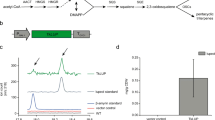Abstract
The yeast C-8,7 sterol isomerase contains a polyvalent high-affinity drug binding site similar to mammalian sigma receptors. Exogenously supplied sigma ligands inhibit sterol biosynthesis in yeast, demonstrating a pharmacological relationship between sigma ligand-binding and C-8,7 sterol isomerase activity. We report the isolation of an Arabidopsis thaliana C-8,7 sterol isomerase by functional complementation of the corresponding sterol mutant in yeast and its characterization by exposure to sigma ligands. The yeast erg2 mutant, which lacks the C-8,7 sterol isomerase gene and activity, was transformed with an Arabidopsis cDNA yeast expression library. Transformed colonies were selected for restoration of C-8,7 sterol isomerase activity (i.e. wild-type ergosterol production) by enhanced resistance to the antibiotic cycloheximide. Sterols produced in complemented lines were characterized by gas chromatography-mass spectroscopy (GC-MS). The full-length A. thaliana cDNA (pA.t.SI1) that complemented the erg2 mutation contains an open reading frame encoding a 21 kDa protein that shares 68% similarity and 35% amino acid identity to the recently isolated mouse C-8,7 sterol isomerase. The sigma ligands, haloperidol, ifenprodil and verapamil inhibited the production of ergosterol in wild-type Saccharomyces cerevisiae and in the erg2 mutant complemented with pA.t.SI1. Structural and biochemical similarities between the A. thaliana C-8,7 sterol isomerase and the mammalian emopamil-binding protein (EBP) are discussed.
Similar content being viewed by others
References
Ashman WH, Barbuch RJ, Ulbright CE, Jarrett HW, Bard M: Cloning and disruption of the yeast C-8 sterol isomerase gene. Lipids 26: 628–632 (1991).
Bak S, Kahn RA, Olsen CE, Halkier BA: Cloning and expression in Escherichia coli of the obtusifoliol 14-alphademethylase of Sorghum bicolor (L.) Moench, a cytochrome P450 orthologous to the sterol 14-alpha-demethylases (CYP51) from fungi and mammals. Plant J 11: 191–201 (1997).
Becker MD, Guarente L: High efficiency transformation of yeast by electroporation. Meth Enzymol 194: 182–187 (1991).
Benveniste P: Sterol Biosynthesis. Annu Rev Plant Physiol 37: 257–308 (1986).
d'Enfert C, Minet M, Lacroute F: Cloning plant genes by complementation of yeast mutants. Meth Plant Cell Biol 49 (part B): 417–429 (1995).
Gachotte D, Husselstein T, Bard M, Lacroute F, Benveniste P: Isolation and characterization of an Arabidopsis thaliana cDNA encoding a 17-sterol-C-5-desaturase by functional complementation of a defective yeast mutant. Plant J 9: 391–398 (1996).
Grebenok RJ, Galbraith DW, Della Penna D: Characterization of Zea mays endosperm C-24 sterol methyltransferase: one of two types of sterol methyltransferase in higher plants. Plant Mol Biol 34: 891–896 (1997).
Hoffman CS, Winston F: A ten minute DNA preparation from yeast efficiently releases autonomous plasmids for transformation of Escherichia coli. Gene 57: 267–272 (1987).
Husselstein T, Gachotte D, Desprez T, Bard M, Benveniste P: Transformation of Saccharomyces cerevisiae with a cDNA encoding a sterol C-methyltransferase from Arabidopsis thaliana results in the synthesis of 24-ethyl sterols. FEBS Lett 381: 87–92 (1996).
Jbilo O, Vidal H, Paul R, De Nys N, Bensaid M, Silve S, Carayon P, Davi D, Galiegue S, Bourrie B, Guillemot J, Ferrara P, Loison G, Maffrand J, Le Fur G, Casellas P: Purification and characterization of the human SR 31747A-binding protein. J Biol Chem 272: 27107–27115 (1997).
Kang MK, Kim CK, Johng TN, Taik YK: Cholesterol Biosynthesis from lanosterol: regulation and purification of rat hepatic sterol 8-isomerase. J Biol Chem 117: 819–823 (1995).
Keon JP, James CS, Court S, Baden-Daintree C, Bailey AM, Burden RS, Bard M, Hargreaves JA: Isolation of the ERG2 gene encoding sterol 18-17 isomerase from the rice blast fungus Magnaporthe griseae and its expression in the maize smut pathogen Ustilago maydis. Curr Genet 25: 531–537 (1994).
Kyte J, and Doolittle RF: A simple method for displaying the hydropathic character of a protein. J Mol Biol 157: 105–132 (1982).
Minet M, Dufour M, Lacroute F: Complementation of Saccharomyces cerevisiae auxotrophic mutants by Arabidopsis thaliana cDNAs. Plant J 2: 417–422 (1996).
Moebius FF, Bermoser K, Reiter RJ, Hanner M, Glossmann H: Yeast sterol C8-C7 isomerase: identification and characterization of a high-affinity binding site for enzyme inhibitors. Biochemistry 35: 16871–16878 (1996).
Moebius FF, Reiter RJ, Hanner M, Glossmann H: High affinity of sigma1-binding sites for sterol isomerization inhibitors: evidence for a pharmacological relationship with the yeast sterol C8-C7 isomerase. Br J Pharm 121: 1–6 (1997).
Paik YK, Trzqskos JM, Shafiee A, Gaylor JL: Microsomal enzymes of cholesterol biosynthesis from lanosterol. Characterization, Solubilization and partial purification of NADPHdependent 18,14-steroid 14-reductase. J Biol Chem 259: 13413–13423 (1984).
Rahier A, Benveniste P: Mass spectral identification of phytosterols. In: Nes WD, Parish EJ (eds) Analysis of Sterol and Other Biologically Significant Steroids, pp. 223–250. Academic Press, New York (1989).
Sambrook J, Fritsch EF, Maniatis T: Molecular Cloning: A Laboratory Manual, 2nd ed. Cold Spring Harbor Laboratory Press, Cold Spring Harbor, NY (1989).
Silve S, Dupuy P, Labit-Labouteiller C, Kaghad M, Chalon P, Rahier A, Taton M, Lupker J, Shire D, Loison G: Emopamilbinding protein, a mammalian protein that binds a series of structurally diverse neuroprotective agents, exhibits 18-17 sterol isomerase activity in yeast. J Biol Chem 271: 22434–22440 (1996).
Author information
Authors and Affiliations
Rights and permissions
About this article
Cite this article
Grebenok, R.J., Ohnmeiss, T.E., Yamamoto, A. et al. Isolation and characterization of an Arabidopsis thaliana C-8,7 sterol isomerase: functional and structural similarities to mammalian C-8,7 sterol isomerase/emopamil-binding protein. Plant Mol Biol 38, 807–815 (1998). https://doi.org/10.1023/A:1006028623875
Issue Date:
DOI: https://doi.org/10.1023/A:1006028623875




